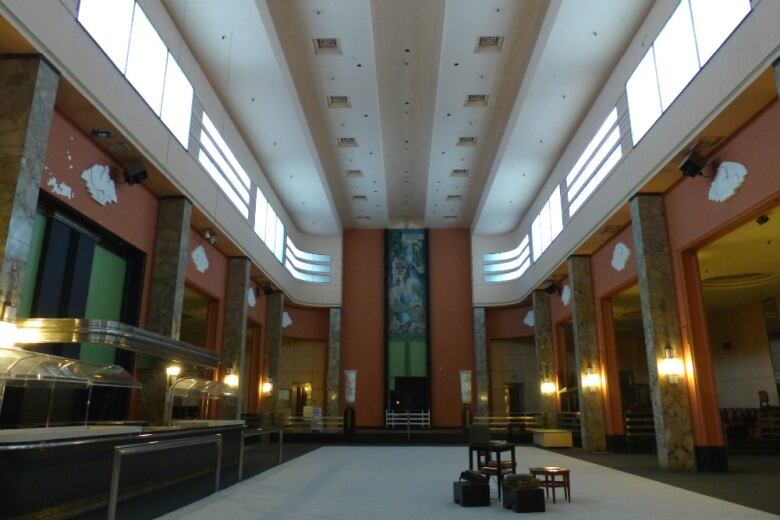Heritage champion dreams of reopening L'le-de-France an art deco masterpiece hidden atop a Montreal mall
Historic restaurant sits trapped in time on 9th floor of former Eaton's store

The urban planner who spearheaded the revival of Little Burgundy's Corona Theatre has a new project: the art deco restaurant that sits empty and perfectly preserved atop the former Eaton's department store in downtown Montreal.
Grald McNichols Ttreault launched a petition to measure public interest in reviving the space, fuelled in part by concern that the current owner may want to recast it as an event space open only to a privileged few.
"At a certain point, we'll be able probably to present it as a World Heritage Site, because it's in perfect condition," McNichols said. "We still have the same plaster on the wall; we still have the same floors the same furniture. It has an extremely high heritage value."
The restaurant, known formally as the Restaurant de L'le-de-France, was built in 1931, with a design meant to evoke a translatlantic ocean liner but on the ninth floor of a building on Ste-Catherine Street.

The decor, the dishes, the utensils and the art were considered so unique that after Eaton's went bankrupt in 1999, the restaurant was rushed into heritage monument status with the Rpertoire du patrimoine culturel du Qubec, the province's heritage register.
That status means the space and its contents cannot be altered, and so the 600-seat space has been trapped in time for 20 years, its tableware and artworkpreserved on shelves like artifacts in a museum archive.
The restaurant's popularity was in part because it was accessible in spite of its opulence, McNichols said. The prices were not aimed at the city's elite, and the clientele crossed the city's various cultural and class boundaries.
"It was a piece of theatre that was played there everyday, but it was always feasible for people with a low budget to go there," he said.
"In French, people would say that it's a place for bonheurit was a thing that gives pleasure to people every time they went there."
"It's a place that unites Montrealers," said McNichols. "We need fun and pleasure like that, and good things to last a long time."
'They do malls. They don't do heritage conservation.'

The owner of the building is Ivanhoe Cambridge, the real estate arm of the Caisse de dpt et placement du Qubec, the province's pension fund.
The problem is, McNichols said,Ivanhoe Cambridge isn't equipped to deal with a heritage space although he doesn't blame them.
"Even if all the Quebecers would like it, it's not their job to satisfy the people," he said. "It's their job to make money."
"They do the best they can do, but they do malls. They don't do heritage conservation."
In the petition, McNichols expresses his concern that the former restaurant could be repurposed as an corporate space good for generating profits, but inaccessible to most people.
Ivanhoe Cambridge's management no longer refers to the site as a"restaurant," the petition says,instead calling it an event space.
"This wasunfortunatelythe case for Eaton's other famous restaurant, Toronto's Round Room, which was restored in 2003 under the name 'The Carlu,' but which now only serves corporate and private events," states the petition.
Take a peek through history at the Art Deco restaurant that now sits empty and perfectly preserved atop the former Eaton's department store in downtown Montreal. pic.twitter.com/orvqfQySo4
—@CBCMontrealIn a statement emailedto CBC Thursday evening,Claude Sirois, president of Ivanhoe Cambridge, said the organization"shares the community's desire to give a new life to the space."
He said the former restaurant isclassified and protected by the Quebec government, and Ivanhoe Cambridge has"never stopped seeking an operating partner to occupy the space with a business plan."
"In order to simply put the space back to current building standards, we will need to invest a minimum of $15 million," said Sirois.
"In our conversations with the Ministry, we have reiterated our intention, upon reopening, to make the space publicly available whenever possible."
McNichols has worked on other restoration projects, including theBonsecours Market and the Corona Theatre, and he managed the conservation project at the Saint-Sulpice Seminary in Old Montreal.
He has ideas about how the former restaurant could be returned to the public, including a not-for-profit model, but he says the first step is making sure that public actually cares.
"For us, as historians or architects or urbanists or even conservationists, it's important to know if the people are behind it," he said.
"It's very important now because we know that in all the historic cities, it's the people who make the difference. If people have an attachment for heritage sites, buildings or monuments, these things can be preserved and restored."












_(720p).jpg)


 OFFICIAL HD MUSIC VIDEO.jpg)
.jpg)



























































































